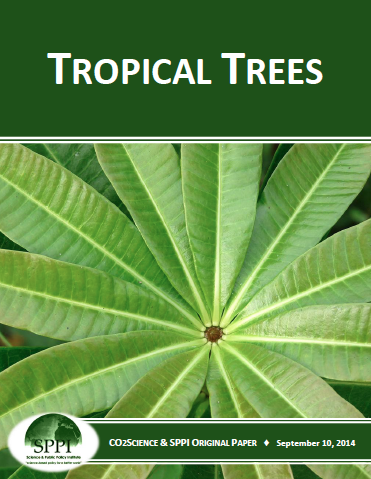News / Science & Technology
Tropical Trees
Citation: Center for the Study of Carbon Dioxide and Global Change. "Tropical Trees.”

Going back in time to the final few years of the 20th century, Schaffer et al. (1997)1 grew two mango ecotypes - one evolving from a warm, humid tropical climate, and the other from a cool, dry subtropical region - for 12 months in glasshouses maintained at either 350 or 700 ppm CO2 in order to determine the effects of atmospheric CO2 enrichment on the trees' growth and leaf mineral nutrient concentrations. In doing so, they found that in addition to the greater net carbon gains of the CO2-enriched trees, the elevated CO2 tended to decrease foliar concentrations of mineral nutrients (N, P, K, Ca, Mg, S, Cl, Fe, Zn, Mn, Cu and B) in both mango cultivars, most likely due to a dilution effect, since atmospheric CO2 enrichment increased leaf dry mass. But with respect to this latter finding, the scientists who conducted the study wrote that "given the slow rate at which global atmospheric CO2 concentration is increasing, it is possible that plants will adapt to this phenomenon over time with respect to mineral nutrition," as actually was found to be the case in a prior study of sour orange trees after 85 months of exposure to elevated CO2 (Penuelas et al., 1997).
One year later, Lin et al. (1998)2 measured the ecosystem carbon exchange rate of a 1700-m3 synthetic rainforest mesocosm that was alternately maintained at atmospheric CO2 concentrations of either 430 or 740 ppm. This enormous study site, managed by Columbia University, was located within the 1.25-ha naturally-lit Biosphere 2 research "dome," which contained several large synthetic ecosystems enclosed by stainless steel sheets and glass. After
the dome's air was stabilized at a treatment CO2 level for about a week, the rainforest mesocosm was isolated from the rest of the dome for one to three days so its carbon exchange rate could be measured. This work revealed that the 72% increase in atmospheric CO2 concentration increased the daytime net ecosystem carbon exchange rate of the synthetic rainforest by 79%, without affecting the amount of carbon respired from the soil, which observation indicated that the CO2-enhanced ecosystem carbon uptake was due primarily to increased canopy net photosynthesis, as the elevated CO2 had no significant effect on soil respiration.
